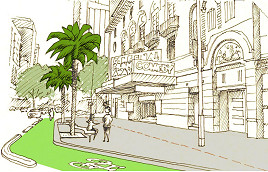Development boom sees Melbourne top $2.5 billion in planning applications
The City of Melbourne’s post-COVID recovery is on track to record more than $2.5 billion in new development applications this year, signalling a robust investor appetite in a growing property market.
New data showed the council was set to assess more than $1 billion in new developments for 2022 – the first time since 2019 – with a further $1.5 billion of state-assessed development projects having been proposed for the municipality so far this year.
More than 600 planning applications worth an estimated $800 million have come before the council this year, with 85 per cent of applications for brand new developments while the rest covered amendments to existing permits.
According to the data, the CBD remained the hottest property market with 200 new development applications, with the majority covering new businesses and shop fit-outs.
Carlton came in second with more than 70 developments, mostly for residential properties or additions to heritage homes. Development applications had also increased in Kensington within the new Arden and Macaulay precinct.
Deputy Lord Mayor Nicholas Reece said the development boom was a testament to the resilience of Melbourne after two years of COVID disruption.
“It’s heartening to see developers continuing to invest heavily in the future of our city,” he said.
“With residential occupancy levels now back to pre-COVID levels and a record number of new hospitality venues opening in the city, it is no wonder that development applications have taken off.”
Cr Reece said there was little doubt Melbourne remained the number one destination for new developments, declaring the “buzz is back and 2023 is shaping up as a year of exciting possibilities for Melbourne”.
“As development interest continues to grow it’s never been more important for the City of Melbourne to prioritise high-quality design, architecture and amenities to ensure the best outcomes for everyone who lives, works, studies or visits our city.”
Cr Reece said the vision to transform West Melbourne into the next Fitzroy or Collingwood under the West Melbourne Structure Plan – which had so far seen a $230 million development proposal made for a West Melbourne Waterfront Precinct – was also gathering momentum, with some distinctive planning applications being approved.
Major state-assessed developments for 2022 included a $750 million development over the Goods Shed in Docklands, and a $264 million development at RMIT Village in North Melbourne. And for the first time, the data revealed the City of Melbourne’s suburbs making the most appeals against new developments.
East Melbourne topped the list, with more than double the number of planning appeals going before the Victorian Civil and Administrative Tribunal compared to any other city neighbourhood.
The CBD had the second-most amount of appeals, while West Melbourne and Docklands had the fewest.
While the rise of new development applications was a promising sign of an economic bounce-back for the city, new occupancy data from the Property Council of Australia, however, showed Melbourne was lagging behind every other capital city, with only 45 per cent of offices in use in October. This was up from 41 per cent in September but still below the yearly peak of 49 per cent in June.
On the busiest days of the week, Melbourne’s office levels were just over half full at 60 per cent, which was slightly higher than the average occupancy levels in Sydney. But less than a third of workers – 32 per cent - made the trip to their desks in the city on the quieter days – as opposed to 40 per cent in Sydney.
The Property Council’s Victorian executive director Cath Evans said while it recognised the efforts of businesses and the City of Melbourne “pulling out all stops” to try and bring back office workers, the return had not eventuated to the levels they’d hoped for.
“While flexible working arrangements will continue to be a feature of our new post-COVID economy, it is a fact that the office plays a crucial role in maximising productivity and collaboration and leads to better learning and development outcomes for employees,” she said. •

Council endorses office tower at Flinders Lane despite querying car park demolition






 Download the Latest Edition
Download the Latest Edition